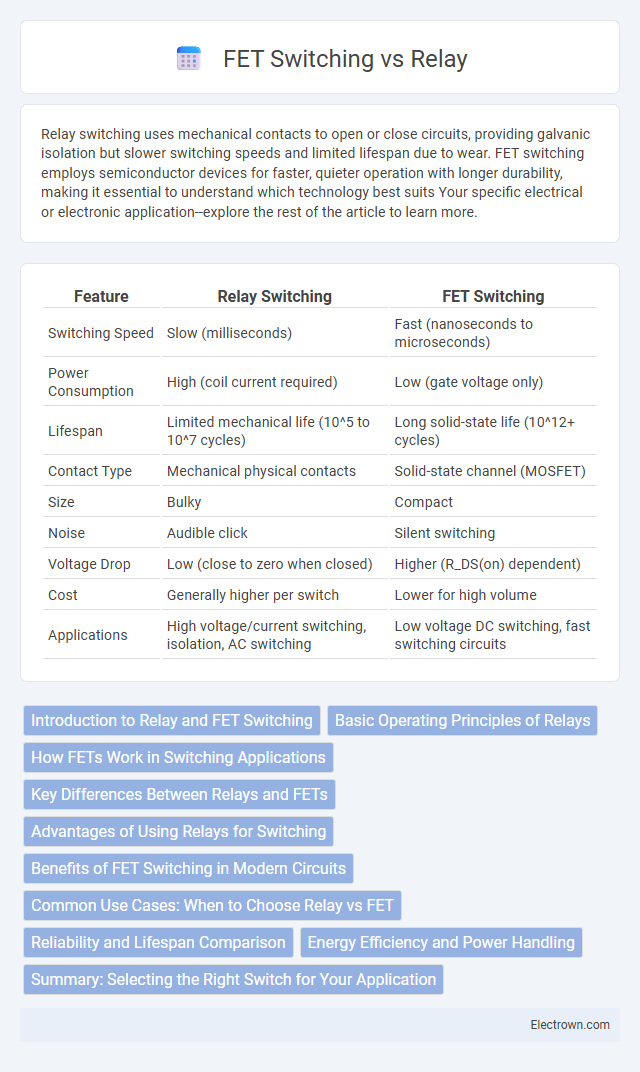Relay switching uses mechanical contacts to open or close circuits, providing galvanic isolation but slower switching speeds and limited lifespan due to wear. FET switching employs semiconductor devices for faster, quieter operation with longer durability, making it essential to understand which technology best suits Your specific electrical or electronic application--explore the rest of the article to learn more.
Table of Comparison
| Feature | Relay Switching | FET Switching |
|---|---|---|
| Switching Speed | Slow (milliseconds) | Fast (nanoseconds to microseconds) |
| Power Consumption | High (coil current required) | Low (gate voltage only) |
| Lifespan | Limited mechanical life (10^5 to 10^7 cycles) | Long solid-state life (10^12+ cycles) |
| Contact Type | Mechanical physical contacts | Solid-state channel (MOSFET) |
| Size | Bulky | Compact |
| Noise | Audible click | Silent switching |
| Voltage Drop | Low (close to zero when closed) | Higher (R_DS(on) dependent) |
| Cost | Generally higher per switch | Lower for high volume |
| Applications | High voltage/current switching, isolation, AC switching | Low voltage DC switching, fast switching circuits |
Introduction to Relay and FET Switching
Relay and FET switching are fundamental methods for controlling electrical circuits, with relays using electromagnetic coils to mechanically open or close contacts, providing isolation between control and load circuits. FET (Field-Effect Transistor) switching employs semiconductor devices that change resistance electronically, offering faster switching speeds and longer life due to the lack of moving parts. Your choice between relay and FET switching depends on factors like current rating, switching speed, isolation needs, and overall system reliability requirements.
Basic Operating Principles of Relays
Relays operate based on an electromagnetic coil that, when energized, creates a magnetic field to mechanically close or open contacts, allowing or interrupting current flow in the switched circuit. This electromechanical action provides galvanic isolation between the control and load circuits, essential for handling high voltages or currents safely. Unlike FET switching, relays physically separate switching elements, enabling them to handle inductive loads and high inrush currents without damage.
How FETs Work in Switching Applications
Field-Effect Transistors (FETs) operate as voltage-controlled switches, allowing or blocking current flow between the drain and source terminals based on the voltage applied to the gate terminal. In switching applications, FETs provide rapid switching speeds and low on-resistance, resulting in efficient power handling and minimal energy loss. Their solid-state nature offers greater reliability and longevity compared to mechanical relays, making them ideal for high-frequency and high-speed electronic circuits.
Key Differences Between Relays and FETs
Relays utilize electromagnetic coils to mechanically switch contacts, offering galvanic isolation and higher current handling, while FETs (Field-Effect Transistors) provide solid-state switching with faster response times and lower power consumption. FETs excel in applications requiring high-speed switching and miniaturization, whereas relays are preferred in circuits needing isolation from high voltages or where signal integrity through physical separation is critical. The primary differences lie in switching speed, lifetime, size, power efficiency, and the presence of mechanical parts in relays versus the semiconductor nature of FETs.
Advantages of Using Relays for Switching
Relays provide electrical isolation between the control circuit and the load, enhancing safety and protecting sensitive components. They can handle higher voltage and current loads compared to FETs, making them suitable for switching heavy-duty devices. Your application benefits from the reliable mechanical switching and inherent protection against voltage spikes offered by relays.
Benefits of FET Switching in Modern Circuits
FET switching offers faster response times, lower power consumption, and greater reliability compared to traditional relay switching, making it ideal for modern electronic circuits. The solid-state nature of FETs eliminates mechanical wear, enhancing longevity and reducing maintenance requirements. Their compact size and high switching speed enable efficient integration in diverse applications, from power management to signal processing.
Common Use Cases: When to Choose Relay vs FET
Relays are ideal for switching high-voltage or high-current loads, such as motors, HVAC systems, and industrial machinery, where electrical isolation and robustness are critical. FETs excel in low-voltage, high-frequency switching applications like power supplies, signal modulation, and battery management due to their fast switching speeds and low on-resistance. Choosing between relay and FET depends on factors such as load type, switching speed, voltage isolation requirements, and efficiency needs in the specific use case.
Reliability and Lifespan Comparison
FET switching typically offers higher reliability and longer lifespan compared to relay switching due to the absence of mechanical moving parts, reducing wear and failure risks. Relays are prone to contact degradation and mechanical fatigue, which limits their operational cycles to around 10^5 to 10^7 switching operations. Solid-state FETs can achieve switching cycles exceeding 10^12, making them ideal for high-frequency and long-term applications.
Energy Efficiency and Power Handling
FET switching offers superior energy efficiency due to its low on-resistance, resulting in minimal power loss during operation compared to mechanical relays. Relays can handle higher power loads and provide galvanic isolation, making them suitable for high-voltage applications despite their higher energy consumption. Your choice between relay and FET switching should consider the balance between energy efficiency and power handling requirements specific to your application.
Summary: Selecting the Right Switch for Your Application
Relays offer mechanical isolation and can handle high voltage and current loads, making them ideal for switching AC power and inductive loads. FET switching delivers faster response times, lower on-resistance, and higher efficiency, which suits low-voltage DC applications and precise electronic control. Choosing between relay and FET switches depends on factors like load type, switching speed, isolation requirements, and power efficiency to optimize performance and reliability.
relay vs fet switching Infographic

 electrown.com
electrown.com